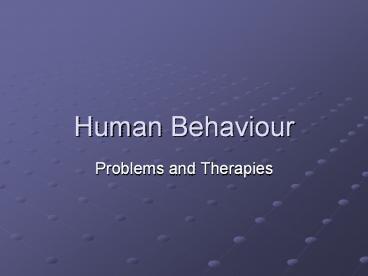Human Behaviour - PowerPoint PPT Presentation
1 / 16
Title:
Human Behaviour
Description:
Human Behaviour Problems and Therapies NEUROSES are exaggerated defence mechanisms used to escape feelings of anxiety. They are a category of mild disorders and ... – PowerPoint PPT presentation
Number of Views:129
Avg rating:3.0/5.0
Title: Human Behaviour
1
Human Behaviour
- Problems and Therapies
2
NEUROSES
- are exaggerated defence mechanisms used to escape
feelings of anxiety. They are a category of mild
disorders and because they last longer than
defence mechanisms, can interfere with the
enjoyment of life. - neurotics show unusual fear and anxiety to escape
certain situations - neurotics understand the nature of their problems
but cant resolve them themselves - since a neurotic person is in touch with reality,
it produces anxiety.
3
Types of Neuroses
- Anxiety Neuroses
- Phobias
- Obsessions
- Eating Disorders
4
Anxiety Neuroses
- fear that dreadful things will happen
- fears are so overpowering the person can not
function - result anxiety attacks ? symptoms include a
pounding heart, faintness, numbness, chills, or
flushed skin - even though everyone experiences anxiety, there
is usually some observable cause( upcoming exam,
car accident) neurotic anxiety occurs without
any obvious cause. - ex the concert pianist might find her hands
paralysed
5
Phobias
- extreme fears of certain objects or situations
- they interfere with our lives
- Skinner and other learning theorists believe
phobias stem from bad experiences and need to be
treated with conditioning techniques that
associate pleasant experiences with the feared
object or situation
6
List of Phobias
7
Obsessions
- - a persistent, unwanted thought that comes from
some sort of anxiety. - - the person may know the fear is unreasonable,
but still cannot get rid of it. - - the obsession is often followed by a compulsion
to perform an act that will relieve the anxiety. - Ex obsession ? fear of germs
- compulsion ? persistent washing of hands
8
Obsessions Eating Disorders
- Anorexia nervosa- anorexics are obsessed with
their body image and reduce food intake, use
laxatives, vomit, and exercise compulsively to
rid of any foods eaten. - Bulimia- bulimics binge-eat, then induce vomiting
or use laxatives and follow with starvation and
fasting. - in therapy patients explore why they feel
compelled to control their body size and shape
and find healthier ways to deal with these
personal conflicts
9
(No Transcript)
10
PSYCHOSES
- a serious mental illness that may prevent the
sufferer form functioning in day-to-day life. - psychotics may distort reality through
hallucinations or delusions - they lack understanding of their own behaviour
and believe their perceptions and distortions are
real. - they may show great personality changes, dramatic
mood swings, strange emotional responses and
confusion with respect to time, places or people. - treatments include drug therapy, psychotherapy,
behaviour modification or hospitalization.
11
Types of Psychoses
- Organic Psychosis
- Manic Depression
- Disassociative Identity Disorder
- Schizophrenia
- Psychopath
12
Organic Psychosis
- result of damage to the brain tissue caused by
injury, untreated syphilis (venereal disease), or
long-term heavy use of drugs or alcohol.
13
Manic Depression
- suffers from extreme mood changes
- the manic stage is marked by confused and
aggressive behaviour. The mood may appear to be
one of joy, but is really exaggerated gaiety. A
person in the manic stage may seem to have
unlimited energy or difficulty sleeping. - - the depressed state is one of extreme fatigue,
sadness and futility. In this state a person may
become extremely withdrawn and even consider
suicide.
14
Disassociative Identity Disorder (formerly called
Multiple Personality Disorder)
- Involves a disturbance in both the memory and
identity of an individual - DID is the presence of two or more distinct
personalities within one body. (Average of 8-13
personalities) - Caused by extreme sustained physical, sexual,
emotional or psychological abuse (usually a
combination of all four) over a prolonged period
of time. - Usually beginning before the age of five and
often occurring in infancy. - Most people with DID start to show signs in their
20s and 30s. - 9 times more women than men receive therapy for
DID - 97 of the individuals with DID have been
physically and/or sexually abused . - People with DID may experience any of the
following depression, mood swings, suicidal
tendencies, sleep disorders, panic attacks and
phobias alcohol and drug abuse, compulsions and
rituals, psychotic-like symptoms (including
auditory and visual hallucinations), and eating
disorders.
15
Schizophrenia
- there are several forms of schizophrenia. Some
simply withdraw into themselves. losing interest
in the world and become completely apathetic. - some have hallucinations and delusions one
patient was convinced that his neighbour was
shooting harmful rays at him through the walls of
his house. - research has increasingly suggested a genetic
cause for schizophrenia, but some psychologists
believe it may be attributed to early environment
or chemical imbalances.
16
Psychopath
- the psychopath has no conscience or superego.
- this type of person feels no remorse or guilt
after doing something immoral or criminal. - they behave antisocially and irresponsibly.
- they find it difficult to form meaningful or
lasting relationships - they have little or no insight into their own
behaviour - some psychologists believe this disorder is the
result of a childhood lacking love and acceptance
because the child learns that there is nothing to
lose by behaving antisocially others believe it
is the result of giving in to the childs every
whim.































